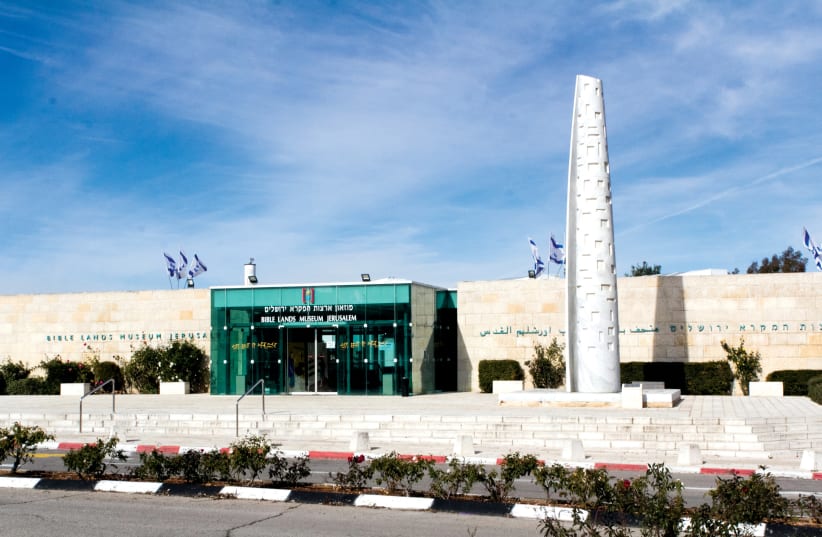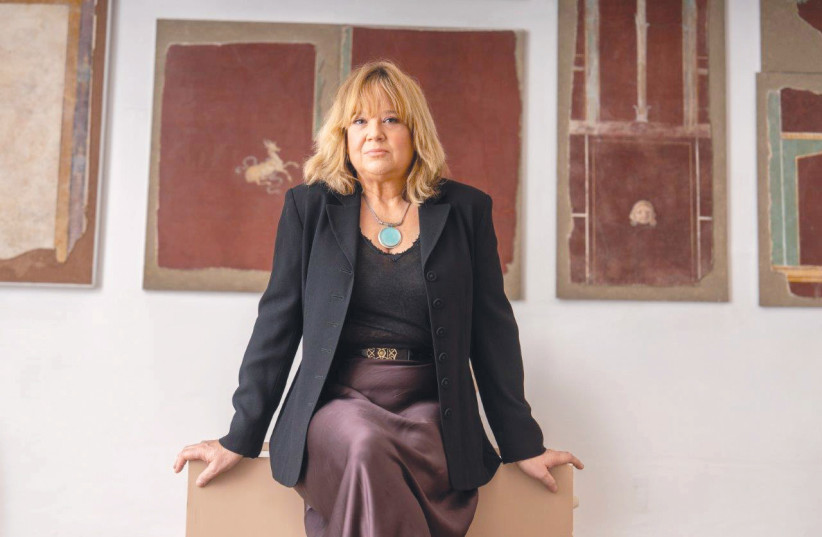The weather was cold and stormy on February 2 for the midday opening of the new exhibition of contemporary art at the Bible Lands Museum Jerusalem (BLMJ). Despite the unpleasant weather, 300 people arrived for the exhibition titled “Splinter from the Storm,” featuring works by 20 contemporary Israeli artists.
BLMJ combines the deep historical and aesthetic connections of the past and interweaves them with the present. Recent contemporary art and ancient artifacts from the museum’s permanent collection from the beginnings of civilization to the Byzantine period in the ancient Near East are displayed throughout the museum’s second level.
The BLMJ was opened in 1992, founded by Dr. Elie and Batya Borowski, who donated a priceless collection of ancient artifacts. “The future of mankind has its roots in the past, and only through understanding our history can we build a better future,” stated Elie Borowski (1913-2003).
The Bible Lands Museum Jerusalem after October 7
After October 7, the BLMJ staff quickly removed one hundred of its most valuable ancient and irreplaceable artifacts from the main gallery displays for safekeeping, with plans to return them after the war.
As the initial shock of October 7 waned, Jerusalem cultural institutions began to look for ways to use their facilities to serve the public. BLMJ pivoted to become a haven for displaced families, offering creative workshops with local artists and musicians, as well as a space for a temporary school for special needs children. By the second week of the war, the BLMJ initiated a collaboration with artists from the Sam Spiegel Studios who volunteered to run art workshops for evacuees. In the first weeks, over 500 people were able to participate.
Risa Levitt, who was appointed executive director at the beginning of 2023, oversees the management, development, and outreach of BLMJ, one of the world’s leading museums of ancient Near Eastern cultures and civilizations. She has over 25 years of experience teaching, researching, and publishing on the Hebrew Bible and Judaism, as well as curating exhibitions of historical and archaeological artifacts. Over the years, she has worked closely with the Israel Antiquities Authority and various international museums, serving as a curator and consultant for several Dead Sea Scrolls exhibitions, and served as a consultant for the Jewish Museum and Tolerance Center in Moscow.
From her background, beginning with a day school education in Toronto and a PhD in history from the University of California, San Diego, and years of experience, she found herself thrust into a most unexpected situation in her new position.
“Through the collaboration, I saw the artists’ current works on display at their studio and thought it would be interesting to house these pieces in our empty gallery space,” she said as she led a private tour of the exhibition for the benefit of The Jerusalem Report. “With new works alongside ancient artifacts, we can perhaps better understand the pain felt by those long ago,” she explained.
Artists were asked to contribute pieces “that connected to the turmoil and chaotic atmosphere both before and during the war,” stated curator Noa Arad Yairi. “There is an immediacy in terms of subject matter such that artists selected materials that dry quickly – watercolor, acrylic, paper – and largely worked with an absence of color. With a few exceptions, most are done in black and gray, while some have an accent of yellow or red. So many of the pieces reflect a sense of urgency – there’s simply no time for oil on canvas in this unstable time,” she added. “After each piece is finished, it’s on to the next one.” Her sculpture When Home Does Not Feel Safe Anymore is a powerful piece using plaster and other materials.
Seeing contemporary works dispersed throughout the BLMJ’s permanent galleries that begin with hunters and gatherers and extends to urban dwellers creates an interesting experience for visitors. The ancient Kingdom of Egypt, Mesopotamia, Rome, Judea, remind us of the various wars and conquerors over the millennia. Using the BLMJ audio guides available at the front desk, explanations are available with a museum app, bringing the ancient worlds and artists’ works and words into the Digital Age.
Irit Abba’s Black and Red Vase, with its rough surface, located near the center of the floor space, draws attention. “Contemporary art intensifies the voices of antiquity, such that history is not a dusty relic but a living thread woven into the fabric of now,” noted Levitt. “The museum can be a bridge across the chasm of time that connects us to our past and helps us understand how to move on into the future.”
Another unique piece is Marleene Rubenstein’s Revolve, started in 2016. She twisted newspaper obituaries in thin strips to create a giant ball that is ongoing and growing. The concluding piece in the tour, Virtues of Hope, has black but also incorporates white spaces into its design.
“Splinter from the Storm” includes more than 40 works of sculpture, ceramics, photography, painting, and new media by artists Irit Abba; Judith Appleton; Noa Arad Yairi; Shir Ben Elul; Sara Benninga; Yael Boverman-Attas; Miri Garmizo; Chana Goldberg; Loti Gombosh; Caron Greenblatt; Michal Greenboim; Yael Ilan; Yaara Leiter; Shachar Levi; Cecilia Lind; Ariane Littman; Orna Millo; Shani Reches; Marleene Rubenstein; and Yuval Yairi. Some of the works were initially displayed as part of the Manofim Contemporary Art Festival in 2023. “Splinter from the Storm” runs through April 30.
Coming soon to the lower level gallery space recently vacated by the special education students is one of the new contemporary art exhibits of the Spring Jerusalem Biennale under the direction of founder Rami Ozeri. The new pieces of contemporary art are to be displayed in the exhibition titled “The Doe of Dawn.” Using a biblical symbol of the feminine divinity, Rachel Verliebter is curating another visual experience to incorporate contemporary art. With the opening planned for on March 13, the exhibition will be on display through Passover. In a way, the Spring Biennale is an extension of the 6th Biennale, which was not able to open in November 2023 as originally planned because of the war.■













